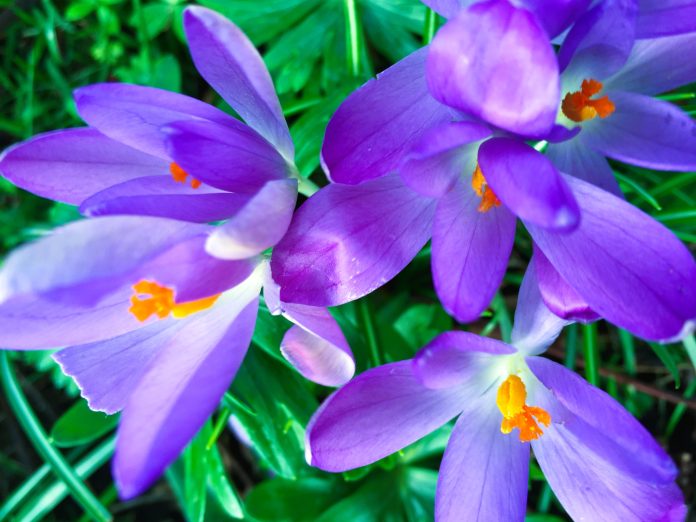Crocuses are among the earliest flowers to bloom, heralding the arrival of spring with their vivid colors. Their adaptability and resilience make them a cherished addition to UK gardens, whether naturalized in lawns, planted in rockeries, or displayed in pots. Here’s how to grow crocus, how to choose the best varieties, care for them, and protect them from pests and diseases.
Choosing the Right Crocus Varieties
Crocuses are divided into spring- and autumn-flowering types, offering gardeners blooms at different times of the year.
Spring-Flowering Crocuses
Popular spring-flowering varieties include Crocus tommasinianus (or “Tommies”), with their star-like purple or lilac flowers that are resistant to squirrels and ideal for naturalizing. Crocus vernus, commonly known as the Dutch crocus, produces larger, vibrant blooms in white, purple, or striped shades, while Crocus chrysanthus—the snow crocus—offers delicate flowers in pastel tones.
Autumn-Flowering Crocuses
Autumn varieties bring a late-season splash of color. Crocus sativus, the saffron crocus, not only offers ornamental appeal but also yields edible saffron. Crocus speciosus features large violet-blue blooms, perfect for borders or naturalized areas. For a subtler look, Crocus pulchellus produces pale lilac flowers with intricate veining.
Planting Crocuses
Crocuses thrive in sunny or lightly shaded areas with well-drained soil. Spring-flowering varieties are planted in autumn, while autumn-flowering crocuses are best planted in late summer.
The timing for planting crocuses depends on whether they are spring- or autumn-flowering varieties. Here’s a breakdown:
Spring-Flowering Crocuses
- When to Plant: Autumn, typically between September and November.
- Why: This gives the corms time to establish roots before winter, ensuring they are ready to bloom in early spring (February to March).
Autumn-Flowering Crocuses
- When to Plant: Late Summer, typically July to August.
- Why: Planting early allows the corms to establish quickly and flower by late September through to November.
For both types, ensure you plant them in well-drained soil in a sunny or partially shaded location. Proper timing is crucial for their successful growth and flowering.
- Depth and Spacing: Plant corms about 8-10 cm deep and 5-7 cm apart, ensuring enough space for natural spread.
- Naturalizing in Lawns: Scatter corms randomly to mimic a natural appearance, planting directly into the turf. Avoid mowing the area until foliage has fully died back.
- Containers: Use a gritty compost mix for drainage, grouping corms for a dense, colorful display.
Care Tips
Crocuses are generally low-maintenance but benefit from attention during key periods:
- Watering: Crocuses need little water once established but avoid letting the soil dry out completely during active growth. Overwatering, especially in winter, should be avoided to prevent rot.
- Feeding: A general-purpose bulb fertilizer applied in early spring can boost flowering.
- After Blooming: Allow foliage to die back naturally, as this replenishes the corm’s energy stores for the next year.
- Dividing Clumps: Every few years, lift and divide overcrowded clumps in early summer, replanting them promptly.
Pests and Diseases
While crocuses are relatively trouble-free, they can be affected by a few pests and diseases:
- Squirrels and Rodents: These animals may dig up newly planted corms. Protect beds with chicken wire or plant resistant varieties like Crocus tommasinianus.
- Slugs and Snails: Emerging shoots can attract slugs, particularly in damp weather. Use organic slug pellets or traps to control them.
- Corm Rot: Caused by fungal infections or overly wet soil, corm rot manifests as soft, discolored patches on the corms. Plant in well-drained soil and avoid waterlogged areas.
- Viruses: Infected crocuses may display stunted growth or streaky discoloration on flowers. Remove and destroy affected plants to prevent the virus from spreading.
Companion Planting
Crocuses pair beautifully with other early-flowering plants such as snowdrops, dwarf irises, and winter aconites, creating a tapestry of color. In lawns, they blend seamlessly with later-blooming bulbs like daffodils and tulips, extending the display through the season.
Conclusion
Crocuses are a joyful addition to any UK garden, providing splashes of color when few other plants are in bloom. By selecting the right varieties, planting them correctly, and protecting them from common pests and diseases, you can enjoy these resilient flowers year after year.




